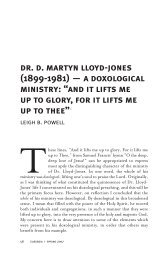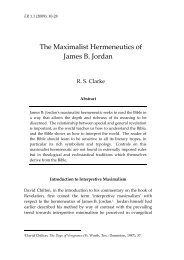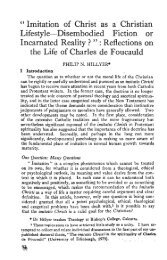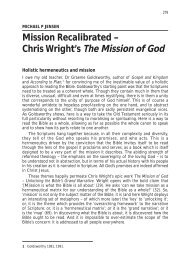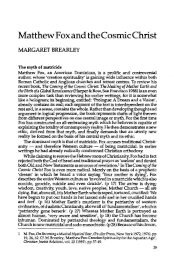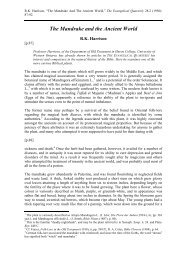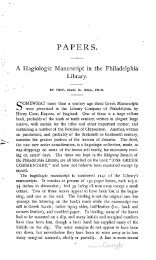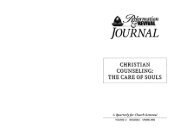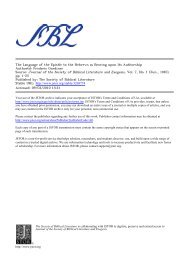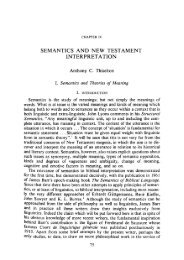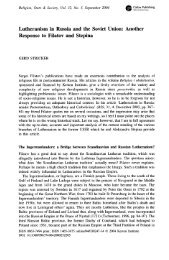Ancient Orient and Old Testament - BiblicalStudies.org.uk
Ancient Orient and Old Testament - BiblicalStudies.org.uk
Ancient Orient and Old Testament - BiblicalStudies.org.uk
Create successful ePaper yourself
Turn your PDF publications into a flip-book with our unique Google optimized e-Paper software.
K.A. Kitchen, <strong>Ancient</strong> <strong>Orient</strong> <strong>and</strong> <strong>Old</strong> <strong>Testament</strong>. London: Inter-Varsity Press, 1966. Hbk. pp.191.<br />
Secondly, the names of the four Eastern kings fit the period c. 2000-1700 BC (<strong>and</strong> some also<br />
later periods). Arioch is an Arriy<strong>uk</strong> or Arriw<strong>uk</strong> (cf. Mari archives, eighteenth century BC) 41 or<br />
Ari<strong>uk</strong>ki (cf. Nuzi archives, fifteenth century BC); 42<br />
[p.44]<br />
Tid‘al is a Tudkhalia, a Hittite name known from the nineteenth century BC onwards, 43 <strong>and</strong> borne by<br />
four or five Hittite kings in the eighteenth to thirteenth centuries BC. 44 Chedor-la‘omer is typically<br />
Elamite (Kutir + x) 45 of the <strong>Old</strong> Babylonian period (2000-1700 BC) <strong>and</strong> later. Amraphel is<br />
uncertain, but is most unlikely to be Hammurapi. 46 The individuals themselves have not yet been<br />
identified in extra-biblical documents, but this is not surprising when one considers the gaps in our<br />
knowledge of the period. 47<br />
41 C. F. Jean, ARMT, II, Letters 63 <strong>and</strong> 64 (see ARMT, XV, p. 142); J.-R. Kupper, Les Nomades en<br />
Mdsopotamie au temps des Rois de Mari, 1957, p. 232 n. 1.<br />
42 I. J. Gelb, P. M. Purves, A. A. MacRae, Nuzi Personal Names, 1943, p. 30a. Over a millennium later,<br />
perhaps cf. an Arioch in Dn. 2: 14, 15.<br />
43 Albright, BASOR 163 (1961), p. 49, n. 66a (no references) ; see J. Lewy, ZA 35 (1924), P. 148 n. 2; F. J.<br />
Stephens, Personal Names from Cuneiform Inscriptions of Cappadocia, 1928, p. 33; I. J. Gelb, Inscriptions from<br />
Alishar <strong>and</strong> Vicinity, 1935, p. 34. Tudkhalia is a name derived from topography (cf. E. Laroche, Les<br />
Hiéroglyphes Hittites, I, 1960, No. 4, <strong>and</strong> P. Garelli, Les Assyriens en Coppadoce, 1963, p. 160, both with<br />
references), <strong>and</strong> is perhaps (proto-) Hattian rather than strictly Hittite (cf. E. Bilgiç, AfO 15 (1945-51), p. 16,<br />
No. 4); also Laroche, Les Noms des Hittites, 1966, pp. 191, 276, 283.<br />
44 It may occur at Ugarit as Tdğl(m), cf. C. Virolleaud, Palais Royal d’Ugarit, II, 1957, p. 65, No. 39: 21; ibid.,<br />
V, 1965, pp. 18, 20, No. 11: 21; cf. Gordon, UM, III, 1955, No. 1923a. Dietrich <strong>and</strong> Loretz, Welt des <strong>Orient</strong>s<br />
3:3 (1966), 201, take this as a word denoting an occupation.<br />
45 Cf. the Elamite royal names Kudur or Kutir-Nah¬h¬unte, KutirShilhaha (W. Hinz, CAH 2 , II: 7 (Persia, c. 1800-<br />
1550 BC), 1964, p. 19); Kudur-mabug of Larsa (Schmökel, HdO, II: 3, pp. 75, 77, 79; Gadd, CAH 2 , I:22<br />
(Babylonia, c. 2120-1800 BC), 1965, pp. 46-48). For -la‘omer/Lagamar/l, cf. de Vaux, RB 55 (1948), p. 334 n. 2<br />
(= Die hebr. Patr., p. 41, n. 2). For the goddess Lagamal or Lakamar at Mari, cf. Kupper, ARMT, XIII, 2400-<br />
1800 BC), 1963, p. 25, <strong>and</strong> esp. I. J. Gelb, A Glossary of <strong>Old</strong> Akkadian, 1957, p. 118 (seal in Legrain,<br />
Publications of Babyl. Section, Univ. Mus., Univ. of Pennsylvania, XIV, No. 138); Scheil, Revue d’Assyriologie 25<br />
(1928), 46. In general, cf. W. Hinz, Das Reich Elam, 1964, Index, s.v.<br />
46 Cf. Albright, op. cit., p. 49 n. 67, <strong>and</strong> earlier studies (n. 66) ; K. Jaritz, ZAW 70 (1958), pp. 255-256;<br />
favouring Hammurapi, F. Cornelius, ZAW 72 (1960), p. 2 n. 4. Against the equation, note (i) the initial ’alephsound<br />
in ‘Amraphel as opposed to the underlying initial ‘ayin in Hammurapi shown by ‘mrpi (=‘Ammurapi) at<br />
Ugarit (Virolleaud, Palais Royal d’Ugarit, V, 1965, pp. 84, 85, No. 60: 2); cf. also Speiser, Genesis (Anchor<br />
Bible), 1964, pp. 106-107; <strong>and</strong> (ii) element -l in Amraphel <strong>and</strong> not in Hammurapi. Some would compare<br />
Amraphel with names like Amud-pi- (or pa-) ila (reading Heb. r as d); on latter name, cf. H. B. Huffmon,<br />
Amorite Personal Names in the Mari Texts, 1965, pp. 128-129.<br />
47 On the irrelevance of such negative evidence, cf. above, pp. 30 f. <strong>and</strong> notes 37-38 with the example of the<br />
Egyptian Fourteenth Dynasty. For gaps elsewhere, compare the four empty centuries in the known history of<br />
Ugarit between the ‘dynastic founders’ Niqmad I <strong>and</strong> Yaqarum (eighteenth century BC) <strong>and</strong> the line of<br />
Ammistamru I in the fourteenth century BC. Only two doubtful names, Ibira (J. Nougayrol, Palais Royal<br />
d’Ugarit, III, 1955, pp. xxxvi-xxxvii, xli) <strong>and</strong> Puruqqu (H. Klengel, OLZ 57 (1962), col. 454) could be<br />
attributed to this whole period, until the recent discovery of a list of former kings of Ugarit (some fourteen<br />
names preserved out of about thirty), cf. Virolleaud, CRAIBL: 1962, 1963, p. 95; Schaeffer/ Weidner, AfO 20<br />
(1963), p. 215, <strong>and</strong> in Schaeffer (ed.), Ugaritica V: 1, 1966, alphabetic text No. 5. Even now, nothing is known<br />
of most of these kings. Gordon’s remarks about ‘dark ages’ (in Altmann (ed.), Biblical <strong>and</strong> Other Studies, 1963,<br />
p. 5) are wide of the mark. And from Mesopotamia, we know of hardly any names of kings of the Second<br />
Dynasty of Ur - a major Sumerian city-state - from either king lists or monuments (cf. Gadd, CAH 2 , I: 13 (Cities<br />
of Babylonia), 1962, p. 23).




